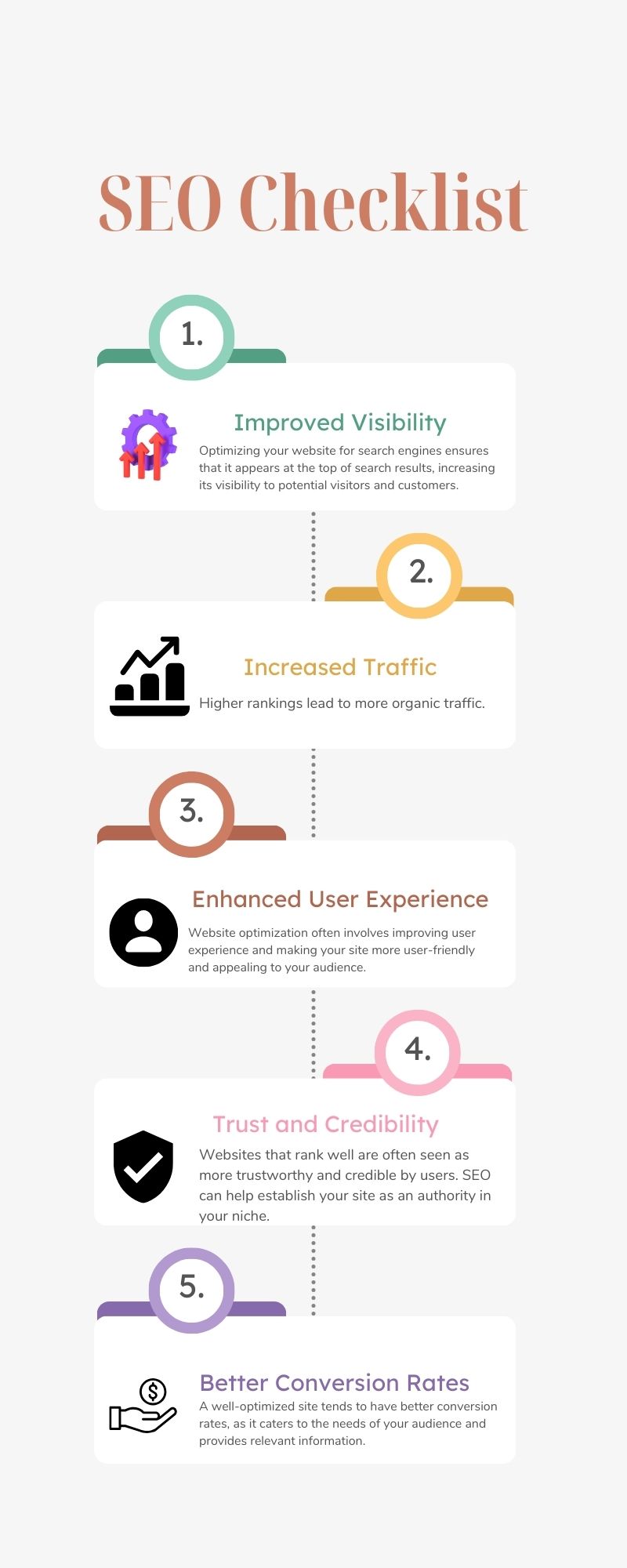In today’s digital age, where more than 5 billion Google searches occur daily, search engine optimization (SEO) is paramount for establishing an online presence and connecting with your target audience. Optimizing your website for search engines is more than just a trend; it’s vital for businesses and individuals looking to enhance their visibility on the web. This article will delve into the concept of website optimization, explore its benefits, outline essential steps for optimization, and provide you with a comprehensive SEO checklist to boost your online presence.
What is Website Optimization?
Website optimization refers to the process of enhancing your website’s content, structure, and performance to make it more attractive to search engines like Google. By aligning your site with search engine algorithms and best practices, you can increase your chances of ranking higher in search results and, consequently, attracting more quality traffic to your website.
Steps to Optimize Your Website
Before diving into our SEO checklist, let’s briefly review the fundamental steps involved in optimizing your website:
- Keyword Research: Identify relevant keywords that your target audience is searching for. These will be crucial in your content and SEO strategy.
- On-Page SEO: Optimize each page on your website by including target keywords in titles, headings, meta descriptions, and content. Ensure your website’s structure is user-friendly.
- Quality Content: Create high-quality, informative, and engaging content that addresses the needs of your audience. This is a cornerstone of successful SEO.
- Mobile Optimization: Ensure your website is responsive and mobile-friendly, as Google prioritizes mobile-first indexing.
- Website Speed: Improve your website’s loading speed, as it’s a crucial ranking factor and impacts user experience.
- Backlinks: Build high-quality, authoritative backlinks to your site from reputable sources to boost your site’s credibility.
- Technical SEO: Pay attention to technical aspects like site architecture, XML sitemaps, robots.txt files, and schema markup to help search engines crawl and index your site efficiently.
- Monitoring and Analytics: Use tools like Google Analytics and Search Console to track your website’s performance and make data-driven improvements.
The Benefits of Web Optimization

- Improved Visibility: Optimizing your website for search engines ensures that it appears at the top of search results, increasing its visibility to potential visitors and customers.
- Increased Traffic: Higher rankings lead to more organic traffic. Websites on the first page of search results typically receive a significant share of clicks, driving more visitors to your site.
- Enhanced User Experience: Website optimization often involves improving user experience and making your site more user-friendly and appealing to your audience.
- Trust and Credibility: Websites that rank well are often seen as more trustworthy and credible by users. SEO can help establish your site as an authority in your niche.
- Better Conversion Rates: A well-optimized site tends to have better conversion rates, as it caters to the needs of your audience and provides relevant information.
SEO Checklist: How to Improve Your Results
Now, let’s explore a comprehensive SEO checklist that you can follow to enhance your website’s optimization:
1. Keyword Research:
- Identify relevant keywords using tools like Google Keyword Planner and SEMrush.
- Focus on long-tail keywords and phrases that are specific to your niche.
- Analyze keyword competitiveness and search volume.
2. On-Page SEO:
- Incorporate target keywords in titles, headings, meta descriptions, and throughout the content.
- Use descriptive and engaging titles and meta descriptions to attract clicks.
- Optimize images with alt tags and compress them for faster loading.
Related: Top 9 Most Important On-page SEO Factors You Need To Know
3. Quality Content:
- Create valuable, well-researched, and unique content that addresses your audience’s needs.
- Develop a content strategy that includes blog posts, articles, videos, infographics, and more.
- Keep content fresh and up-to-date.
4. Mobile Optimization:
- Ensure your website is responsive and adapts to various screen sizes.
- Test your site’s mobile-friendliness using Google’s Mobile-Friendly Test tool.
- Prioritize a seamless mobile user experience.
5. Website Speed:
- Use tools like Google PageSpeed Insights to analyze and improve page loading times.
- Optimize images and leverage browser caching.
- Consider using Content Delivery Networks (CDNs) to distribute content efficiently.
6. Backlinks:
- Acquire high-quality backlinks from reputable websites in your industry.
- Focus on natural and organic link-building techniques.
- Avoid spammy or low-quality backlinks, as they can harm your SEO efforts.
7. Technical SEO:
- Create an XML sitemap to help search engines index your site.
- Optimize your site’s structure for easy navigation.
- Implement schema markup to enhance search results with rich snippets.
8. Monitoring and Analytics:
- Set up Google Analytics to track visitor behavior and engagement on your site.
- Use Google Search Console to monitor your site’s indexing status and resolve errors.
- Regularly review and adjust your SEO strategy based on data insights.
Conclusion
Website optimization is an ongoing process that requires continuous effort and adaptation to stay competitive in the online landscape. You can significantly improve your website’s visibility, attract more quality traffic, and achieve your digital marketing goals by following this SEO checklist and staying informed about the latest SEO trends and updates. Remember that SEO is not just about ranking high in search results but also providing a valuable and user-friendly experience for your audience.



